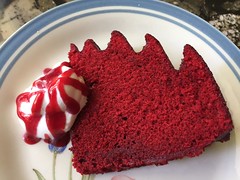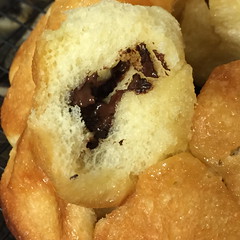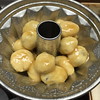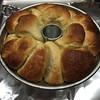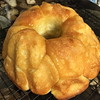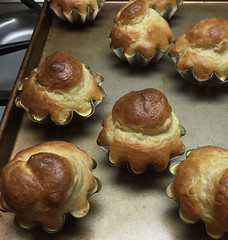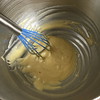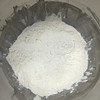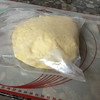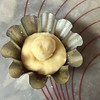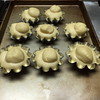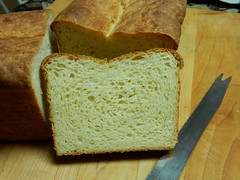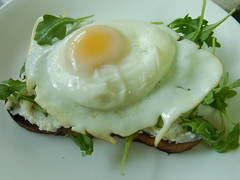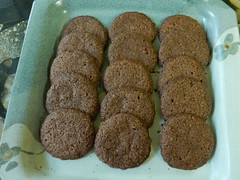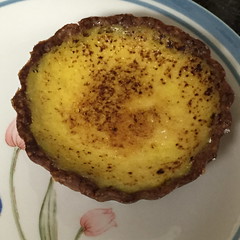
My attempt at the French Orange Cream Tart was not my finest baking hour, and that's a pity--this is a very nice flavor combination, reminiscent of a favorite ice-cream recipe my mother made, an orange cream sherbet. The tart has a patê sucrée crust, blind-baked then filled with a pretty simple filling of reduced orange and lemon juices, cream, zest, egg yolks, and sugar. The filled tarts then bake until the filling is almost not-jiggly. (Or to 185 degrees F, if you prefer.) After the tarts cool and are chilled, a little powdered sugar is sprinkled on top, caramelized with a torch, chilled briefly, then the sugar application and torching repeat. This gives a light crunchy sugar topping to the tart.
I decided on a half-recipe as I often do, and on tartlets. My little 3 inch by 1 inch pans looked about right, and Rose's Pie and Pastry Bible gave the detailed instructions on judging how much dough was needed for each and how thin to roll it (1/16"). I did make a full recipe of the patê sucrée, figuring I'd have a higher dough-to-filling ratio with the tartlets, plus leftover pie dough is generally not a problem. (Rose suggests making hamentaschen with the leftovers, but I'm thinking fruit tarts.) I didn't have a good gage for how many tartlets a half recipe of the 9.5 inch tart would make, so went with 6 shells. See above re: extras are no problem.
My baking issue was some distraction while baking the tart shells as I chatted with a neighbor, which led to getting the tart shells between almost burned and very brown in the blind-baking step. I'm so far behind on my baking that starting over was not happening, so I set out the shells from least over-baked to most, made the filling, and filled them up in order. Four tartlets turned out to be just right to hold the amount of filling, and the 2 really-almost-burned shells went in the trash.
Everything else went according to plan. I chopped my grated lemon and orange zest by hand with the sugar, beat that with the egg yolks with a hand mixer (the small amount would be lost in the KitchenAid), beat in the cream, and finally beat in the cooled, reduced orange and lemon juice. The baking and bruleeing went according to plan.
I got taste-tests from younger niece and the nephew next door, and my sister-in-law took a nibble. They agreed with my comment about it resembling the orange cream sherbet, and liked the flavor though the nephew, I think, would have liked a stronger orange. Both found it too sweet, and we immediately decided this needs to be repeated but with limes or key limes, not increasing the sugar for the tarter fruit. And next time I'll be sure to not over bake the tart shells.


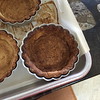
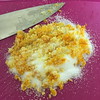
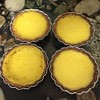

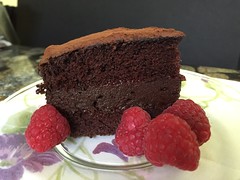 A short writeup this week, though the cake deserves more. The Double Damage Oblivion is a flourless chocolate cake (the Chocolate Oblivion) sandwiched in between layers of a regular chocolate cake (the Deep Chocolate Passion). The recipe calls for gluing these together with ganache, but I had leftover raspberry sauce from the Red Velvet Cake, which made a fine substitute for the ganache with only the effort of getting a container out of the fridge.
I made a half-sized cake, using my 6" springform and a 6" cake pan. This was a bit trickier than usual, as the two individual cake recipes are fairly small. Cutting them in half, I was glad of my scale to weigh fairly precisely in grams and had to use a hand-held mixer because the volumes were too small for the big stand mixer to reach.
I thought this was a good cake, though if I hadn't used the raspberry as a contrast flavor it might have been a bit one-note for me. My chocoholic sister-in-law, however, has informed me I must keep this recipe. For once it wasn't too sweet for her (probably because I used darker chocolate than called for at about 72% cacao instead of 60%, plus a dusting of unsweetened cocoa powder), and she also approved of the contrasting raspberry sauce.
A short writeup this week, though the cake deserves more. The Double Damage Oblivion is a flourless chocolate cake (the Chocolate Oblivion) sandwiched in between layers of a regular chocolate cake (the Deep Chocolate Passion). The recipe calls for gluing these together with ganache, but I had leftover raspberry sauce from the Red Velvet Cake, which made a fine substitute for the ganache with only the effort of getting a container out of the fridge.
I made a half-sized cake, using my 6" springform and a 6" cake pan. This was a bit trickier than usual, as the two individual cake recipes are fairly small. Cutting them in half, I was glad of my scale to weigh fairly precisely in grams and had to use a hand-held mixer because the volumes were too small for the big stand mixer to reach.
I thought this was a good cake, though if I hadn't used the raspberry as a contrast flavor it might have been a bit one-note for me. My chocoholic sister-in-law, however, has informed me I must keep this recipe. For once it wasn't too sweet for her (probably because I used darker chocolate than called for at about 72% cacao instead of 60%, plus a dusting of unsweetened cocoa powder), and she also approved of the contrasting raspberry sauce.









